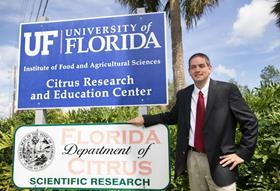
From nutritional supplements to managing irrigation to grower outreach and education, University of Florida/IFAS researchers are finding additional ways to support Florida citrus growers in their fight against citrus greening disease (HLB).
Twelve projects were funded by the state legislature-funded Citrus Initiative programme for 2017/18 that looked at possible short- and long-term solutions that growers might implement now, that could impact fruit growth, reduce production costs and result in more HLB-tolerant trees.
“We focused on both short- and long-term research that moves us closer to viable grove management as well as possible tactics that a grower might experiment with immediately,” said Michael Rogers, UF/IFAS statewide director of citrus programmes and director of the Citrus Research and Education Center at Lake Alfred, Florida.
For example, one project studied the use of Homobrassinolides on HLB-infected trees. While work on this project continues, the preliminary results have shown improvements in the health of HLB-affected trees including an increase in fruit size.
“This is a new product that is registered for use on citrus and is something that a grower might want to experiment with on a small number of acres,” Rogers shared.
Projects were funded at three UF/IFAS research and education centers: the Citrus REC in Lake Alfred, the Southwest Florida REC in Immokalee and the Indian River REC in Ft. Pierce.
Funds supported further research on the Citrus Under Protective Screen (CUPS) growing strategy for fresh fruit. The project has produced results that confirm strong fruit production with high quality in systems of screen house-grown citrus.
The screen house-grown citrus (in houses of approximately 20 acres) remained free of the Asian citrus psyllid (ACP) – the insect that transmits the bacterium that causes greening -- for every weekly inspection in 2017/18. There were no detectable cases of HLB disease in the screen house both by visual or DNA-amplication testing after nearly four years. This is a viable alternative for fresh fruit growers.
Citrus initiative funds also supported numerous trainings and educational materials provided to citrus growers and residents.
These materials are resources for the identification and management of canker, HLB, black spot and exotic diseases. Nearly 3,500 people were trained to identify canker, HLB and black spot or other citrus related issues.
Tens of thousands of identification and managements sheets, field identification pocket guides and other instructional materials were distributed throughout the state.






No comments yet